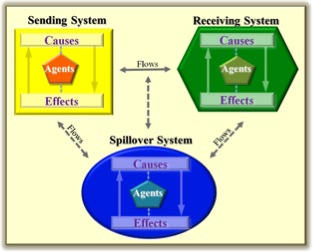What is telecoupling?
Add Summary

Nov. 12, 2013
Jackie Hulina was a master's student in the Michigan State University's Center for Systems Integration and Sustainability.
Where do I fit into this picture? How can I possibly help to sustain an entire species?
That’s just it – you’re never alone in science. Previously, I mentioned the phrase “standing on the shoulders of giants,” but the great thing about science is that I actually get to work with the “giants” of Kirtland’s warbler recovery.
In the past few months, I’ve been talking to all sorts of people involved in Kirtland’s warbler recovery about current problems and how to start working on solutions.
One of the major concerns is that Kirtland’s warblers are conservation-reliant, meaning that they rely heavily on humans to manage their habitat. In fact, their whole history has been heavily interwoven with that of humans, resulting in both decline and recovery. As such, we need to be able to understand the effects of human interactions with Kirtland’s warblers populations.
There’s just one big problem – most previous research has been disciplinary. In other words, social scientists don’t like to sit at the same lunch table as biologists. This isn’t necessarily a bad thing because disciplinary studies have resulted in understanding of specific pieces of a system.

We have to change people’s perceptions (aka encourage biologists and social scientists to sit at the same table). First, we need to give them an idea of how to approach a problem that bridges between different disciplines. My adviser, Dr. Jack Liu, and his colleagues have been solving this problem by introducing the idea of Coupled Human and Natural Systems (CHANS).
CHANS are exactly what they sound like – a way to study interacting human and natural systems together. Unlike previous research, CHANS recognize that humans are a part of natural systems, not apart from them. Read more about CHANS here.
However, CHANS are only equipped to handle one location at a time. For a migratory species like Kirtland’s warblers, which link two distant systems, we need a new approach that builds upon the idea of CHANS.
In response to the limits of CHANS, Dr. Liu and company created another conceptual framework called telecoupling. Telecoupling is an integrative way to study coupled human and natural systems that are linked over long distances (ex. avian migration).
Telecoupling has the potential to answer questions regarding how to sustainably manage habitat as well as how to identify, prioritize, and respond to threats to Kirtland’s warblers because it allows ecological and human dimensions to actively inform each other.
The telecoupling framework is made up of five interconnected components: Systems, Agents, Flows, Causes, and Effects.
Causes, and Effects.
Systems, which may be classified as sending, receiving, or spillover, refer to coupled human and natural systems in which humans and their environments interact. Agents are the decision-making parties involved in the telecoupling, which affect how materials and information Flow between the Systems. Causes define the circumstances that create the telecoupling and change its dynamics, resulting in socioeconomic and environmental Effects.
You’re probably thinking, “Whoa, slow down! So how do you actually apply telecouplin



 Print
Print Email
Email









